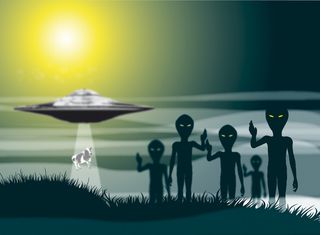Alien Abductions May Be Vivid Dreams, Study Shows

Researchers say they have conducted "the first experiment to ever prove that close encounters with UFOs and extraterrestrials are a product of the human mind."
In a sleep study by the Out-Of-Body Experience Research Center in Los Angeles, 20 volunteers were instructed to perform a series of mental steps upon waking up or becoming lucid during the night that might lead them to have out-of-body experiences culminating in encounters with aliens. According to lead researcher Michael Raduga, more than half the volunteers experienced at least one full or partial out-of-body experience, and seven of them were able to make contact with UFOs or extraterrestrials during these dream-like experiences.
Raduga designed the experiment to test his theory that many reports of alien encounters are actually instances of people experiencing a vibrant, lifelike state of dreaming. If he could coach people to dream a realistic alien encounter, he said, that could prove that reports of such encounters are really just a product of our imaginations.
"When people experience alien abductions in the night, they usually don't know they are actually in REM sleep and having an out-of-body experience," Raduga told Life's Little Mysteries, adding than an estimated 1 million Americans have such experiences each year. "It's very realistic and people cannot understand how it happens. [Our study] shows that it's not about aliens, it's about human abilities, and it can happen to almost anyone." [7 Things that Create Convincing UFO Sightings]
Study participants were told to try to "separate from their bodies" every time they became half-awake or lucid during the night. If they were able to dream that they had separated from their sleeping bodies, they were then supposed to look for aliens in their homes. If they were unable to have an out-of-body dream experience, they were told to go back to sleep and try again later in the night.
"Some could do it by the first attempt. Some needed three to five attempts to have an out-of-body experience. Not everybody could do it — some were unable to do it because of their fear. They were able to separate from their body but they became too afraid to look for aliens," Raduga said.
By the end of the study, 35 percent of the volunteers said they had made visual contact with aliens, and they described their encounters for the researchers.
Get the Space.com Newsletter
Breaking space news, the latest updates on rocket launches, skywatching events and more!
One participant, identified as Alexander N., recalled making a successful attempt to separate from his body: "I [then] tried to find aliens. Three of them materialized right before my eyes. They seemed more like creatures from the movie 'The Thing' than tadpoles with eyes like Princess Jasmine. They wanted to scare me, not to 'make contact.' As a result, I was extremely frightened and regained awareness in my own body."
Raduga plans to publish his results and to conduct further studies on humans' ability to fabricate alien encounters that seem real.
This story was provided by Life's Little Mysteries, a sister site to SPACE.com. Follow Natalie Wolchover on Twitter @nattyover. Follow Life's Little Mysteries on Twitter @llmysteries, then join us on Facebook.
Join our Space Forums to keep talking space on the latest missions, night sky and more! And if you have a news tip, correction or comment, let us know at: community@space.com.

Natalie Wolchover was a staff writer for Live Science and a contributor to Space.com from 2010 to 2012. She is now a senior writer and editor at Quanta Magazine, where she specializes in the physical sciences. Her writing has appeared in publications including Popular Science and Nature and has been included in The Best American Science and Nature Writing. She holds a bachelor's degree in physics from Tufts University and has studied physics at the University of California, Berkeley.

